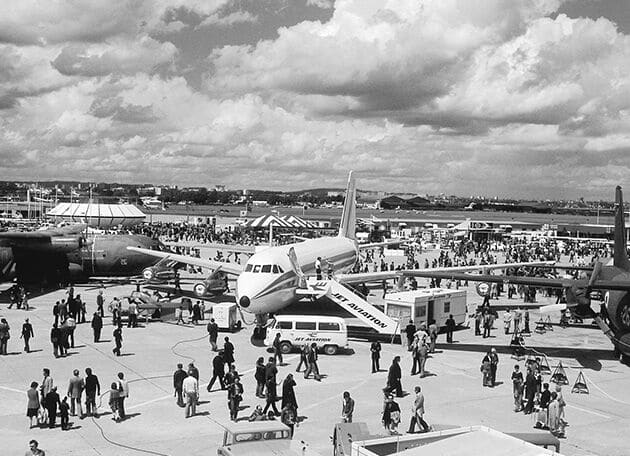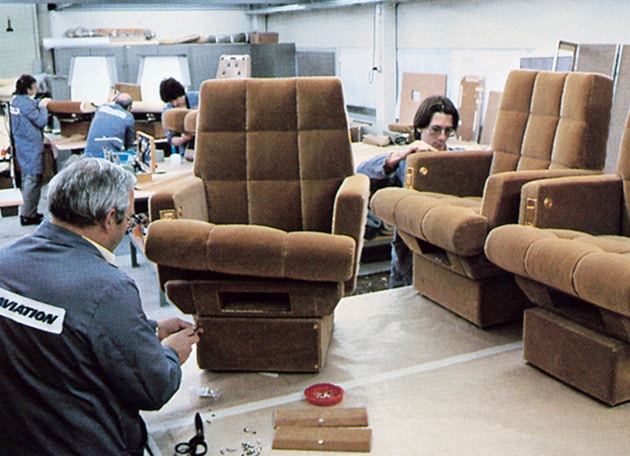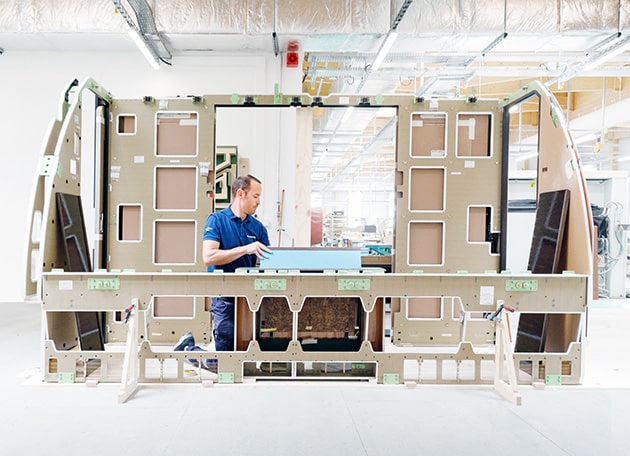45 Years of Completions

In June 1977 at the Paris Airshow, Jet Aviation unveiled arguably the world’s first bespoke VVIP interior.
Since then, Jet Aviation has crafted some 400 custom interiors, half of these at our completion facility in Basel, including around 70 narrow- and wide-body ACJ and BBJ interiors. Each is one-of-a-kind: a hand-made reflection of a customer’s individual aesthetic or idea.
“We were pioneers in 1977, and we remain innovators, leading the industry, today,” says Jeremie Caillet, SVP Regional Operations EMEA. “The designs and technology may have changed, but our teams’ commitment to pushing the boundaries in search of the ultimate cabin experience has remained the same. From Design to upholstery, cabinetry to planning, engineering to installation, and everyone else: it is their passion, their expertise and their commitment that continues to set us apart. Thank you.”
Join us as we take a look down memory lane to see how cabin interiors have changed over the decades, and how our own capabilities have evolved as we continue to explore what is possible in VVIP completions.
“I’m incredibly proud to be celebrating 45 years of completions with the team,” says Christoph Fondalinski, VP Completions. “It’s a remarkable achievement, and one that we could never have reached without our team here in Basel. Many of our completions team have been here almost as long as we have been crafting interiors, and their expertise and commitment to creating the ultimate cabin experience for our customers is commendable. Thank you to the team for 45 exceptional years – I look forward to many more years to come.”
“Our teams’ commitment to pushing the boundaries in search of the ultimate cabin experience has remained the same for 45 years. From Design to upholstery, cabinetry to planning, engineering to installation, and everyone else: it is their passion, their expertise and their commitment that continues to set us apart. ”
In the Beginning:
Completions was another of the innovative ideas that propelled Jet Aviation to success in its early years. As oil prices rose in the 1970s, the potential customer base ialso increased, and the boom in business gave Jet Aviation founder, Carl Hirschmann, an idea. He imagined converting the interiors of these large aircraft into elegant and personalized cabins for his customers. So he did.
Jet Aviation’s first completion was in an old four engine ex-Cathay Pacific Convair 880 jet airliner that Hirschmann had acquired in 1976. According to Elie Zelouf, Hirschmann approached him in early 1977 with the idea of converting the interior.
His idea was to showcase this new capability at the Paris Airshow, four months from the start of the project. "It was the first time in European industry that an aircraft had been completed and displayed," remembers Zelouf. "It was something people could hardly imagine at that time, and absolutely everyone was excited. Thousands walked through the aircraft, and after that, the completions contracts started rolling in."
Changing Tastes:
From the very beginning, completions was all about what the customer wanted. The Jet Aviation teams worked with the customer to create their personalized cabin interior – from layout to furnishing, aesthetic to technology. Whatever a customer required, we were there to make it happen. As our customers evolved, so did these designs. Aviation interiors have often mirrored the tastes of the times, with customer’s wanting to replicate their home and yacht interior design style and comforts in the air.
“We see a lot of classic era styles in the early completions,” remarks Grischa Schmidt, Senior Director Design. “Shag rugs in the 70s, gold finishes in the 80s, embellished detailing in the 90s, etc. In the first decade of the new millennium, it was all about veering away from more ornate interiors, and now we see customer’s requesting minimal styles, using bare, natural essentials to create a simple and groomed space.”
Our in-house Design Studio, opened in 1995, has allowed us an even greater understanding of what exactly these styles and tastes might entail.
“We work either one-on-one with the customer, or with their designer, to ensure that every element of their idea can be transformed into a reality,” says Schmidt. “Having a Design Studio on-site means that we are experts in both the intricacies of aviation interior design, and can draw on our team’s experience in architecture, residential design and yacht interiors, to create something truly personal and beautiful, yet fully feasible within the constraints of business aviation.”
What ‘fully feasible’ means has also evolved: “In the late 20th century, for instance movie and TV systems were considered a luxury in an aircraft,” explains Schmidt. “Now we can provide customers with wireless systems and charging, curved LED screens seamlessly blending into the interior, connectivity, immersive experiences, adaptive lighting, and sustainability in regards to ecologically sensitive materials and continuous improvement on the sound and weight balance of the cabin.”
As the way customers use the cabin has changed, layouts have evolved to meet a more open-plan living style, with an increased ability to integrate technologies from the ground, in the air.
“Traditionally the aviation industry lagged behind residential design, because of the time frames involved in getting something certified. One big change has been our ability to move with the times,” continues Schmidt. “Today, we are able to use a lot more of the current trends in design, technology and comforts, meaning we can create a cabin that is more similar to a customer’s home. We are seeing this in the type of entertainment technology that we are able to install, environmental elements such as ambient lighting and humidity, and how customers can virtually interact with the cabin – what was previously a control panel, can now be an app.”
In the end, it’s all about personal choice. The wide range of design, engineering and production capabilities, and the technology associated with them, means customers can be as interactive as they would like, with their technology as evident, or as hidden, as suits their own personal taste.
“As design trends on the ground also become more sophisticated and complex, we are also seeing this in aircraft cabins,” says Schmidt. “Our customers’ passion for detail has only grown over the decades, and we strive to achieve this for them.”
“Another key evolution has been a commitment to sustainability. In our most recent concept, an experimentation with material and form allows more sustainable pieces and practices to permeate the design, such as the table marble marquetry which could potentially make use of stone offcuts; natural fibers used throughout the cabin; Nuo flexible wood which enables an easier way to integrate wood, and the use of water-based paint to bring in contrast but to also reduce the use of wood; and innovative textiles such as a non-textile flooring produced from recycled materials, and largely manufactured with fossil fuel free techniques."

A Commitment to Innovation
In 1977, Jet Aviation entered the market of designing and producing bespoke narrow- and wide-body interiors for VIP clientele. What Jet Aviation produced back then was at the forefront of what was possible to install in an aircraft. But as these large aircraft have evolved over the decades, so has what we are able to do inside of the cabin.
“Aircraft manufacturers are producing ever more efficient aircraft, employing more sophisticated technologies,” comments Matthew Woollaston, VP Completion Sales. “The technology incorporated in aircraft is evolving at an ever-increasing rate. Each new generation of aircraft is more fuel efficient, quiet and capable than the last, and customer’s want to make the most of that. This has driven completion centers to focus on cabin weight and the acoustic properties of their cabin design in order to ensure the best qualities of the aircraft are realized in the final product.”
“We are industry leaders in the balance between sound and weight and this is a big evolution in VVIP completions. Our redeliveries of last year were proof to this point. All were examples of how we continue to lead the industry in beautifully custom-built interiors, and with an ongoing focus on the balance of weight and sound. To redeliver an aircraft that is not only light, but also exceptionally quiet, is a fantastic achievement, and testament to our continued work and innovation in this area. As we focus on creating the ultimate customer experience, our engineering and production teams are committed to pushing the boundaries of what is considered possible in VVIP completions.”
Pushing these boundaries also means something different today than 45 years ago. “The criteria demanded of regulatory bodies to achieve cabin certification is significantly more rigorous and robust than it was in the past,” explains Woollaston. “Flying in an aircraft has never been as safe as it is today. In order to reach even greater levels of safety, certifying bodies are much more advanced in their analysis of the engineering and design of today’s cabins. Designs and installation techniques that were permitted forty years ago, would not be possible today.”
Our teams, working with the certifying bodies, constantly refine their capabilities and methods to bring solutions to our customers and create interiors that are complex and contemporary, while being technically feasible and — most importantly — safe. Today, we have on-site engineering and design teams, collaborating closely with our upfront and production to achieve the ultimate cabin experience.

Same, same, but different
Of course, we would not be a completions center, without our Production team. They craft almost every piece which goes into the finished interior, working closely with design, engineering and installation to create an exceptionally beautiful and detail-oriented interior. Every millimeter is considered, every gram measured.
“While the completions industry has changed, one thing has remained the same,” says Raphael Naegelen, Director Production Project Management. “That is our dedication to exceptional hand-craftsmanship. Many of our Production team have been here for decades, and as technologies and tastes change, their expertise has remained a constant and many of our monuments are produced using traditional hand craftsmanship skills. This allows us to exercise incredible attention to even the smallest detail and draw on decades of experience in all techniques, from cabinetry to upholstery, electrical installation to finishing.”
While our commitment to bespoke handcraftsmanship has been a cornerstone of our completions business for 45 years, there have been technological advancements along the way. “Of course, the industry has evolved,” continues Naegelen. “However, the way we use technology is more in our process than in our craft. For example, our fit-check platforms enable us to ensure a perfect fit, before the monument goes to the aircraft, while the 3D and CNC machines help us speed up the initial stages of cabinetry, and UV varnish significantly reduces drying time of varnish.
“We continue to innovate in these areas as well. We are developing new products to further enhance our finishing and working with external laboratories to test the lifecycle of different finishes and how we can maximize this for our customers.”
The shops also came together some ten years ago as one team to further efficiencies, and in mid-2021 we opened our new 8,000 square-meter Production Center, which enabled even closer communication and collaboration in a state-of-the-art environment.
At the heart of all of this, however, are our people. As customer requirements have become veer more complex, our craftspeople have consistently risen to the challenge, adding their input at almost every stage of the process.
“The involvement of Production has also evolved,” says Naegelen. “We are asked for input in the upfront stage and the design stage, so that we can collaborate with colleagues in these areas to ensure we can realize a customer’s dream we even create samples of especially complex pieces so a customer can see and feel a final product. We have also started to connect our customers with our experts in the shops at various steps in the process. This means they can ask questions of the real experts and collaborate on certain techniques.”
One thing that has evidently remained the same, through technological and design evolution, is the passion of our people for the interiors we produce. 45 years of completions; 45 years of passion. Thank you to everyone past and present who made it happen!
